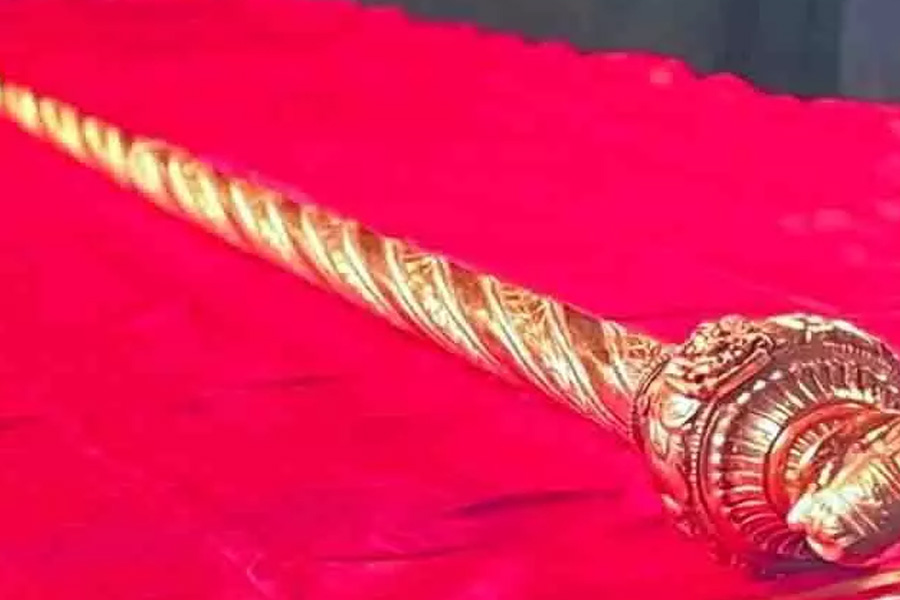PM Modi will establish holy Sengol in the new building of Parliament, know its history

PM Modi will establish holy Sengol in the new building of Parliament, know its history
Holy Sengol
New Delhi (IANS) | Prime Minister Narendra Modi is going to inaugurate the newly constructed building of Parliament on 28 May. On this important day, PM Modi is also going to install the holy Sengol in the new building of Parliament. This sengol was brought from Tamil Nadu in the year of India’s independence i.e. 1947, which was handed over to Jawaharlal Nehru, the then and first Prime Minister of independent India, by the British as a symbol of transfer of power on 14 August 1947 at around 10:45 pm. was assigned Union Home Minister Amit Shah while giving information about Prime Minister Modi installing Sengol in the new building of the Parliament, said that on the occasion of ‘Amrit Mahotsav of Independence’, the country’s Prime Minister Narendra Modi will dedicate the newly constructed building of the Parliament to the nation on May 28. He said that this new Parliament House is a proof of the foresight of Prime Minister Modi. It is a beautiful attempt to combine our cultural heritage, tradition and civilization with modernity in building a new India.
Referring to the old historical tradition of Sengol, Shah further informed that a historical tradition dating back ages will also be revived and restored on the historic occasion of the inauguration of the new Parliament building.
Referring to the tradition followed at the time of independence of the country and the transfer of power from the British to India, Shah said that a unique incident took place on August 14, 1947. At that time Jawaharlal Nehru was handed over Sengol brought from Tamil Nadu as a symbol of transfer of power. Referring to this tradition being associated with the Chola Empire, he said that when Prime Minister Modi came to know about this tradition in 1947, he ordered an investigation into where Sengol is now.
Today, after 75 years of independence, most of the citizens of the country are not aware of this, while Sengol played an important role in the history of India. It became a symbol of the transfer of power in Sengol 1947. After a lot of research, it was found that this Sengol is kept in the Allahabad Museum.
Shah further informed that it was decided that it was inappropriate to keep this sacred Sengol in a museum. Therefore, after receiving this Sengol of 1947, it was decided that on the same day the new Parliament House would be dedicated to the nation, Prime Minister Narendra Modi would humbly accept this Sengol from Adhinam in Tamil Nadu and present it in the new Parliament House. It will be installed near the seat of the Speaker of the Lok Sabha.
Giving information about the entire process at the time of independence of the country, Shah said that in 1947, when Lord Mountbatten asked Jawaharlal Nehru how to transfer power, Nehru sought suggestions from C Rajagopalachari about it. . He told Jawahar Lal Nehru about the Sengol process of the Chola Empire. After this, this sacred Sengol was brought from Tamil Nadu and on 14 August 1947, at around 10:45 pm, the British handed over this sacred Sengol to Jawaharlal Nehru as a symbol of transfer of power.
While giving information about the program of May 28, Shah also said that the Tamil scholar who was present at the time of handing over Sengol to Nehru in 1947, is 96 years old today and the same 96-year-old Tamil scholar will be the new Speaker of the Parliament on May 28 as well. Will be present at the time of installation of Sengol in the building. On the occasion, Shah also launched a website to disseminate information related to the tradition and history of Sengol in the presence of Union Ministers Anurag Thakur and G Kishan Reddy.
Recalling the entire program that took place on the occasion of India’s independence, Amit Shah said, today even after 75 years of independence, most of India is not aware of this event. It was a special occasion on the night of August 14, 1947, when Jawaharlal Nehru received Sengol from the specially arrived Adhinams (priests) from the Thiruvaduthurai Adhinam (monastery) in Tamil Nadu. Sengol’s involvement with Pandit Nehru was precisely the moment when power was transferred by the British into the hands of Indians. This very moment is what we are celebrating as independence. Prime Minister Narendra Modi has decided to adopt Sengol as the national symbol of Amrit Kaal. The new building of Parliament will witness the same event, with Adhinam repeating the ceremony and presenting the Sengol to Prime Minister Modi.
Explaining in detail about Sengol, the Union Home Minister further said that Sengol has a deep meaning. The word sengol is derived from the Tamil word semmai, which means righteousness. It is blessed by the chief adhinam (priests) of a prominent religious monastery in Tamil Nadu. As the observer of ‘justice’, the hand-engraved Nandi sits atop it, watching with his unflinching gaze.
Most importantly, the person holding the Sengol is ‘ordered’ (‘aanai’ in Tamil) to rule justly and fairly and this is what is most noteworthy – chosen to serve the people. Those who have gone should never forget this. The same Sengol of 1947 will be installed prominently near the Speaker’s seat in the Lok Sabha by Prime Minister Modi. It will be displayed for the nation to see and taken out on special occasions





